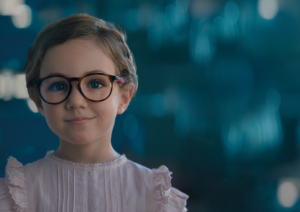sponsored content
November 1, 2021
By Mark Bullimore, MCOptom, PhD, FAAO
Effective spectacle options for myopia control have finally arrived. They are well tolerated and have very little effect on vision.

Photo: Essilor® Stellest™- (c) Essilor International – All rights reserved
Myopia control with spectacles has a 60-year history, beginning with bifocals.1 Unfortunately, there have been multiple false dawns regarding effective treatment options.
PALs Have Low Efficacy
Twenty years ago, a study suggested that progressive addition spectacle lenses (PALs) slowed myopia by 0.50D or more over two years.2 Unfortunately, this was not borne out by three randomized clinical trials that, collectively, enrolled over 800 children.3-5 The largest found a three-year reduction in progression of 0.20D with PALs compared to single vision lenses in U.S. children (COMET Study) — statistically significant but clinically irrelevant.4 Also, virtually all of the effect was observed in the first year. The trial was repeated in myopic children with high accommodative lag and esophoria.6 The mean three-year treatment benefit of PALs was less than 0.30D and, like the original COMET study, was clinically unimportant.
Executive Bifocals May or May Not Work
Greater success has been reported for executive bifocals. Cheng et al. randomized 135 myopic children to single-vision lenses or +1.50D executive bifocals, with or without 3-∆ base-in prism in the near segment.7 Mean three-year myopia progression was -2.06D, -1.25D, and -1.01D for single vision lenses, bifocals, and prisms bifocals, respectively. The findings contradict a previous clinical trial of 207 children randomized to single vision lenses, +1.00D add, or +2.00D add executive bifocals for a period of three years.8 The mean progression was around -0.35D per year in all three groups.8 It is unclear why these two trials would find such contrasting results, but regardless, executive bifocals are a cosmetically unappealing option.
New Technology with Limited Success
Newer spectacle lens technology has shown mixed success. Lenses designed to reduce peripheral hyperopic defocus — essentially concentric PALs — were evaluated.9,10 No differences were observed in the rates of progression with the novel designs compared to single vision lenses. One of the lenses was commercialized (MyoVision, Carl Zeiss) and evaluated in younger children with at least one myopic parent.10 The mean two-year progression in the MyoVision group (-1.43D) was no different from that in the control group (-1.39D).
Recent Breakthroughs
Greater success was recently reported with Defocus Incorporated Multiple Segments (DIMS) spectacle lenses developed at the Hong Kong Polytechnic University.11 This design comprises a 9mm central optical zone and a 33mm annular zone with multiple 1mm segments having a relative positive power of +3.50D. Close inspection is required to see the lenslets. Among the 160 children completing a two-year trial, the mean myopic progression was -0.41D in the DIMS group and -0.85D in the control group. The myopia control effect of the DIMS lenses was more significant in older children. These lenses are now marketed in parts of the world by Hoya as the MiyoSmart lens.
Other novel designs from SightGlass Vision are in clinical trials (ClinicalTrials.gov Identifier: NCT03623074). These lenses use Diffusion Optics Technology specifically designed to reduce retinal contrast signaling through the incorporation of thousands of light-scattering elements. The underlying hypothesis is that high amounts of contrast detected by the retina may lead to axial elongation and myopia.
Myopia control technology has been further advanced using spectacle lenses with highly aspherical lenslets (HAL).12 The geometry of the aspherical lenslets (1.1mm in diameter) generates a volume of myopic defocus from 1.2mm to 1.9mm in front of the retina. The contiguous lenslets are arranged in 11 concentric rings centered around a 9mm-diameter clear central zone. The one-year efficacy of the HAL lenses was compared to single vision lenses in a randomized clinical trial (54 children assigned to the HAL lenses group and 52 in the SVL group). The mean progression in the single vision group was -0.81D, while children wearing the HAL lenses progressed by only -0.27D. Interestingly, progression was faster in younger participants wearing single vision lenses, but age did not influence rate of progression in the HAL wearers. Two-year results confirm the high efficacy of the HAL lenses with slowing of progression by 0.80D and axial elongation by 0.35mm.13 The lenses were well tolerated by wearers. The Essilor Stellest lens is based on the same technology as the HAL prototype.
New Designs Have Limited Effect on Vision
A legitimate concern is the vision of children wearing these new lens designs. Distance visual acuity and contrast sensitivity were measured in a large group of myopic children wearing HAL, DIMS, and single vision lenses.14 Measurements were made with subjects viewing only through the lenslets zone. The HAL lenses had a significantly lower impact on VA and contrast sensitivity than the DIMS lenses.
The impact of the HAL design on vision was evaluated further in a recent publication.15 Visual acuity and reading speed were measured for high and low (10%) contrast letters for foveal fixation through the peripheral portion. There was no significant change at high contrasts compared to a single vision control, but at low contrasts, visual acuity and reading speed were slightly changed. Of course, wearers would not be trying to read such low contrast materials. The impact of the lenslets on peripheral vision was also assessed while subjects fixated through the center of the lens. The HAL design did not affect peripheral motion perception or useful field of view (a test of visual attention).
A Bright Future
Effective spectacle options for myopia control have finally arrived. They are well tolerated and have very little effect on vision.

Mark Bullimore, MCOptom, PhD, FAAO, is an internationally renowned scientist, speaker, and educator based in Boulder, Colorado. He received his Optometry degree and PhD in Vision Science from Aston University in Birmingham, England. He spent most of his career at the Ohio State University and the University of California at Berkeley and is now Adjunct Professor at the University of Houston.
This article is sponsored by Essilor.
References
- Mandell RB. Myopia control with bifocal correction. Am J Optom Arch Am Acad Optom 1959;36:652-8.
- Leung JT, Brown B. Progression of myopia in Hong Kong Chinese schoolchildren is slowed by wearing progressive lenses. Optom Vis Sci 1999;76:346-54.
- Edwards MH, Li RW, Lam CS, et al. The Hong Kong progressive lens myopia control study: study design and main findings. Invest Ophthalmol Vis Sci 2002;43:2852-8.
- Gwiazda J, Hyman L, Hussein M, et al. A randomized clinical trial of progressive addition lenses versus single vision lenses on the progression of myopia in children. Invest Ophthalmol Vis Sci 2003;44:1492-500.
- Hasebe S, Ohtsuki H, Nonaka T, et al. Effect of progressive addition lenses on myopia progression in Japanese children: a prospective, randomized, double-masked, crossover trial. Invest Ophthalmol Vis Sci 2008;49:2781-9.
- Progressive-addition lenses versus single-vision lenses for slowing progression of myopia in children with high accommodative lag and near esophoria. Invest Ophthalmol Vis Sci 2011;52:2749-57.
- Cheng D, Woo GC, Drobe B, Schmid KL. Effect of bifocal and prismatic bifocal spectacles on myopia progression in children: three-year results of a randomized clinical trial. JAMA ophthalmology 2014;132:258-64.
- Grosvenor T, Perrigin DM, Perrigin J, Maslovitz B. Houston Myopia Control Study: a randomized clinical trial. Part II. Final report by the patient care team. Am J Optom Physiol Opt 1987;64:482-98.
- Sankaridurg P, Donovan L, Varnas S, et al. Spectacle lenses designed to reduce progression of myopia: 12-month results. Optom Vis Sci 2010;87:631-41.
- Kanda H, Oshika T, Hiraoka T, et al. Effect of spectacle lenses designed to reduce relative peripheral hyperopia on myopia progression in Japanese children: a 2-year multicenter randomized controlled trial. Jpn J Ophthalmol 2018;62:537-43.
- Lam CSY, Tang WC, Tse DY, et al. Defocus Incorporated Multiple Segments (DIMS) spectacle lenses slow myopia progression: a 2-year randomised clinical trial. Br J Ophthalmol 2020;104:363-8.
- Bao J, Yang A, Huang Y, et al. One-year myopia control efficacy of spectacle lenses with aspherical lenslets. Br J Ophthalmol 2021.
- Bao J, Huang Y, Yang A, et al. Myopia control with spectacle lenses with aspherical lenslets: a 2-year randomized clinical trial. Invest Ophthalmol Vis Sci 2021;62:2888.
- Li X, Ding C, Li Y, et al. Influence of Lenslet Configuration on Short-Term Visual Performance in Myopia Control Spectacle Lenses. Front Neurosci 2021;15:667329.
- Gao Y, Lim EW, Yang A, et al. The impact of spectacle lenses for myopia control on visual functions. Ophthalmic Physiol Opt 2021;41:1320-31.













